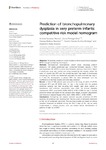Prediction of bronchopulmonary dysplasia in very preterm infants: competitive risk model nomogram

Ver/Abrir
Use este enlace para citar
http://hdl.handle.net/2183/36035Colecciones
- Investigación (FCS) [1293]
Metadatos
Mostrar el registro completo del ítemTítulo
Prediction of bronchopulmonary dysplasia in very preterm infants: competitive risk model nomogramAutor(es)
Fecha
2024-02-20Cita bibliográfica
Sucasas-Alonso A, Pértega-Díaz S, Balboa-Barreiro V, García-Muñoz Rodrigo F, Ávila-Álvarez A. Prediction of bronchopulmonary dysplasia in very preterm infants: competitive risk model nomogram. Front Pediatr. 2024. 12:1335891.
Resumen
[Abstract] Objective: To develop predictive clinical models of bronchopulmonary dysplasia (BPD) through competing risk analysis.
Methods: Retrospective observational cohort study, including preterm newborns ≤32 weeks gestational age, conducted between January 1, 2013 and September 30, 2022 in a third-level Neonatal Intensive Care Unit in Spain. A prediction study was carried out using competing risk models, where the event of interest was BPD and the competing event was death. A multivariate competing risk model was developed separately for each postnatal day (days 1, 3, 7 and 14). Nomograms to predict BPD risk were developed from the coefficients of the final models and internally validated.
Results: A total of 306 patients were included in the study, of which 73 (23.9%) developed BPD and 29 (9.5%) died. On day 1, the model with the greatest predictive capacity was that including birth weight, days since rupture of membranes, and surfactant requirement (area under the receiver operating characteristic (ROC) curve (AUC), 0.896; 95% CI, 0.792–0.999). On day 3, the final predictive model was based on the variables birth weight, surfactant requirement, and Fraction of Inspired Oxygen (FiO2) (AUC, 0.891; 95% CI, 0.792–0.989).
Conclusions: Competing risk analysis allowed accurate prediction of BPD, avoiding the potential bias resulting from the exclusion of deceased newborns or the use of combined outcomes. The resulting models are based on clinical variables measured at bedside during the first 3 days of life, can be easily implemented in clinical practice, and can enable earlier identification of patients at high risk of BPD.
Palabras clave
Bronchopulmonary dysplasia
Prediction
Death
Mechanical ventilation
Preterm
Prediction
Death
Mechanical ventilation
Preterm
Versión del editor
Derechos
Creative Commons Attribution Licence 4.0 International (CC-BY 4.0)
ISSN
2296-2360





